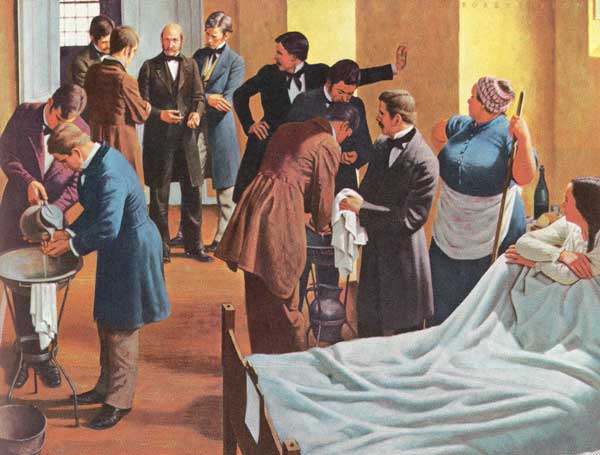Ignaz Semmelweiss and the spread of infection
When most women had their babies at home, looked after by women in the family or a local midwife, serious infections after the birth were quite rare. But in the late 18th and 19th century doctors began to deliver babies more often, hospitals set up maternity wards and the problems began. Soon after giving birth many women developed a range of symptoms including severe pain, high fever, inflammation of the womb, vomiting and convulsions. Death usually followed within 5 days. This dreadful illness, known as childbed or puerperal fever, killed many women who had a baby in hospital. Nobody really understood why this was happening.
Ignaz Semmelweiss (sometimes spelled Semmelweis) was a Hungarian doctor who worked in the maternity clinic at the Vienna General Hospital. The hospital had two delivery rooms, one staffed by female midwives and the other by medical students. Over 12% of the women whose babies were delivered by the doctors died of childbed fever, more than three times as many as those delivered by midwives. Semmelweiss realised that his medical students often went straight from dissecting a dead body to delivering a baby without washing their hands first. He wondered if they were carrying the cause of the disease on their hands from the corpses to their patients.

Semmelweiss overseeing young doctors washing their hands
Then another doctor cut himself while dissecting a body, and died of an infection with symptoms identical to those of childbed fever. Now Semmelweiss was convinced that the deadly fever was caused by an infectious agent. He insisted that the medical students wash their hands in chlorinated lime before they went onto the maternity ward. Eventually he insisted that they wash their hands between each patient as well. Within 6 months the death rate for Semmelweiss's patients had dropped to a quarter of the original figure. In 2 years it had dropped to just over 1%.
Semmelweiss could not get other doctors to accept his findings, in spite of all the evidence he collected. Many doctors thought that pain and suffering during and after childbirth was God's punishment to women. It was also hard for many doctors to admit that they themselves might have killed their patients instead of curing them.
Hand washing was much more difficult in the 19th century that it is today. There was no running water in the buildings. All the water was cold and the chemicals used to wash in, such as chlorinated lime, eventually damaged the skin on the hands.
Without understanding the cause of infectious diseases Semmelweiss had discovered a key factor in preventing the spread of pathogens which is just as important now in the 21st century as it was in the 19th century.













